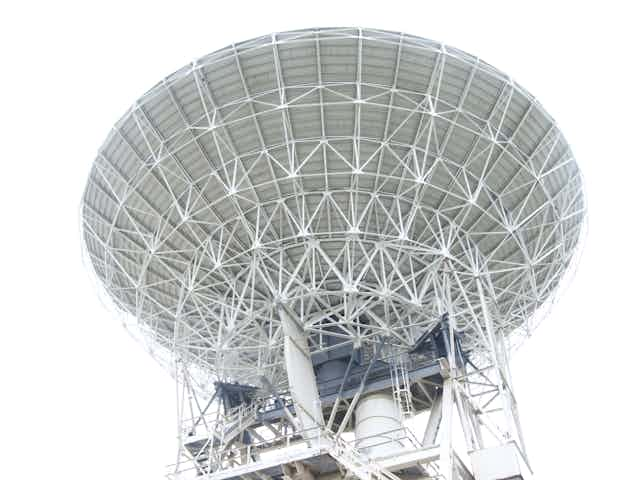The Square Kilometre Array (SKA) is the world’s largest radio telescope project, which will collect data over one million square kilometres from radio astronomy telescopes on the African and Australian continents. In the long run the two-phased SKA could possibly help scientists answer questions in astrophysics, cosmology and fundamental physics. Phase one of the project entailed setting radio telescopes in South Africa and Australia. Phase two will include more telescopes being added by partner countries, New Zealand and the eight African countries namely: Botswana, Ghana, Kenya, Mauritius, Madagascar, Mozambique, Namibia and Zambia. The full array should be up and running by 2030, but the first phase is expected to be operational by 2023. The launch of Ghana’s radio telescope is a critical part of this process. Dr Bernard Duah Asabere explained its significance.
How did Ghana get involved in the project and how does it fit in?
Ghana has had a redundant satellite communication antenna in Kutunse – a suburb 25 kilometres north-west of the capital, Accra.
Between 2011 and 2017 this antenna has been undergoing refurbishment for use as a radio astronomy telescope. At the end of the first engineering phase, the refurbished telescope is capable of participating in global network observations using a technique known as Very Long Baseline Interferometry (VLBI). It also be used in single dish or standalone operational mode.
Interferometry is a technique in which collections of telescopes scattered over a large area function as a single radio telescope. The Very Long Baseline Interferometry technique is most well-known for:
imaging distant cosmic radio sources,
tracking spacecraft, and
for applications in astrometry.
But the technique can also measure the time differences between the arrival of radio waves from separate antennas to the same source in the sky. This helps astronomers get a better image resolution of an object or a region in the universe.
Put simply, if different telescopes at different locations are all tuned to observe the same source in the sky at the same time, astronomers can get fine details of the specific object being observed.
The countries that make up the African SKA project are each building their own radio telescopes or converting redundant telecommunication dishes so that they function as a network known as the African VLBI Network (AVN).
Ghana now becomes the first country in the African SKA partners besides South Africa to have a telecommunication antenna converted to realise the African VLBI Network. With Ghana’s telescope now operational, it means that South Africa and Ghana will be able to do joint observations. When the other seven African SKA partner countries get theirs ready, they will join the African’s network.
Kenya, Mozambique and Zambia are contending to add the next telescope to the network.

How did we know the Ghanaian telescope was ready and what will it do?
Across the globe there are several very long base interferometry networks: Europe has one, as does Australia and America. Any telescope across the world is able to join an observation in one of these networks.
After Ghana re-engineered the antenna into a functional radio astronomy telescope, it needed to do a science commissioning of the facility to see if the refurbishment was successful and it could track and observe astronomical sources in the sky and join international observations.
When Ghana tested its telescope it was able to detect methanol masers, observe pulsars and also succeeded in participating in an observation with 15 other telescopes which form part of the European very long base interferometry network.
Until now South Africa has been the only country on the continent that had been joining in VLBI observations with other countries’ networks because it was the only country with a radio telescope on the continent.
With radio telescopes in Ghana and South Africa, an African network is now given birth to. Aside being a part of the African network, Ghana could join other telescopes on the globe to do science observations.
What is the significance of Ghana’s telescope for astronomy in Africa?
There are many celestial objects to observe in the Universe: planets, masers, galaxies, meteorites, stars and even regions in the sky. And there are global questions that astronomy community is interested in addressing. This includes questions like: is there any life outside earth? Are there other stars that are as prominent as the sun? How did the universe come into being? These are questions that the SKA will attempt to address.
If Africa has its own network, astronomers on the continent can choose what celestial objects and regions it wants to observe.
If we look at most of the existing telescopes across the world, there has been a hole in Africa. Telescopes situated in the Northern hemisphere are unable to see the region of the sky in the southern hemisphere. With an African very long base interferometry network set up, astronomers in Africa can now observe both the northern and southern hemispheres of the sky from the continent.
What is Ghana bringing to the party and what does it hope to get out of this SKA collaboration?
The facility at Kutunse will be used as a science instrument but also as a training facility. Ghana will help the other seven countries that form part of the African network refurbish their unused antennae.
Although this technology is not new and has been done in Australia, Peru, Japan and the UK, no other country in Africa has done this.
For Ghana, developing the skills, regulations and institutional capacity in the partner countries is a vital part of building the square kilometre array on the continent over the next decade. This is because it will optimise African participation in the SKA.
Ghana will build it robust research community in a field never before accessible to the country.
But there is also the prospect of improving the radio astronomy capacity in the country. Ghana’s radio astronomy development strategy forms part of the broader Ghana Science, Technology and Innovation Development Plan.

